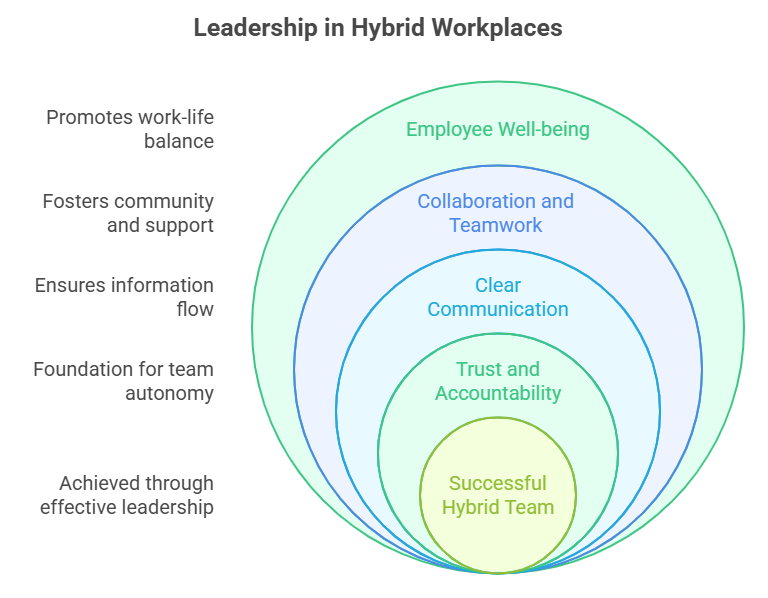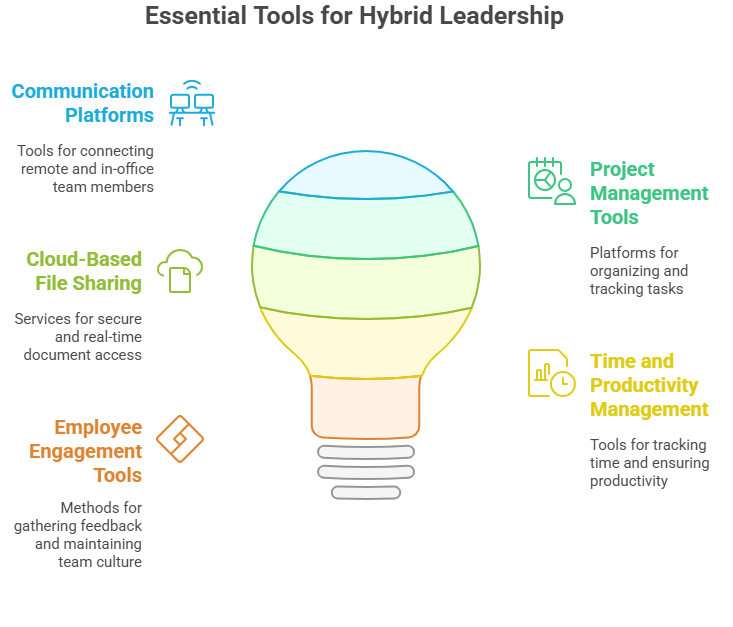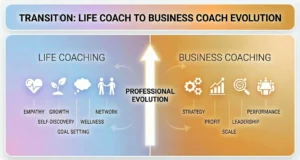The way we work is changing. The traditional office setup is no longer the only way things get done. Instead, Toronto businesses are embracing a hybrid model, where employees split their time between working from home and the office. This shift is not just a trend; it’s a new way of doing business.
But leading a hybrid team? That’s a different challenge altogether. It’s like managing a group of people in various places, both physically and mentally. How do you ensure everyone stays on the same page when some are in the office and others are at home? How do you keep communication flowing and morale high when you can’t all meet face-to-face every day?
In this article, we’ll dive into how leaders in Toronto can succeed in a hybrid work environment. From building trust and clear communication to using the right tools and strategies, you’ll discover practical tips that will help you lead with confidence, whether your team is remote, in the office, or a mix of both. So, let’s get into it!
Understanding Hybrid Workplaces
A hybrid workplace is simple in theory: it mixes remote and in-office work. This type of workplace combines the flexibility of working from home with the structure of in-person office work. Employees might spend a few days working from the office and the rest at home or a location of their choice. It’s a model that gives people more control over their workday, balancing professional and personal life.

This approach is gaining traction because it works. Employees enjoy the freedom and flexibility of remote work, while businesses can still maintain some level of in-person collaboration. Plus, it’s cost-effective, reducing commuting and office space needs. For companies in Toronto, this shift is not just about responding to a trend; it’s a strategy to attract and retain top talent in an ever-competitive job market.
A hybrid model benefits both employees and employers:
- For employees: Less time spent commuting, more control over where and how they work.
- For employers: A wider talent pool, including employees who may not be located near the office.
- Overall impact: Happier employees, higher productivity, and a better work-life balance.
But here’s the thing: this setup only works if the right strategies are in place. It’s not just about letting people choose where they work; it’s about building a system that supports both flexibility and productivity. Here’s why structure and systems are key to a successful hybrid model. Let’s explore how leadership can make that happen.
Leadership in Hybrid Workplaces: Key Responsibilities
Leading a hybrid team is like juggling; you’ve got to keep several balls in the air at once, each one requiring attention and balance. Some team members are in the office, some are remote, and it’s up to leaders to ensure everything stays connected and running smoothly.If you’re ready to evolve your leadership capabilities, explore how to transform your leadership style in today’s workplace.

It’s not just about managing tasks but also about maintaining trust and engagement. So, what does leadership in a hybrid environment really require?
Build Trust and Accountability
Trust is the foundation of any successful team, especially in a hybrid setup. Without constant in-person interaction, employees need to feel trusted to manage their own time and deliver results. As a leader, it’s essential to give your team the autonomy they need but hold them accountable for outcomes.
This means setting clear goals, checking in regularly, and letting your team take ownership of their work.
Communicate Clearly and Consistently
Communication is the glue that holds hybrid teams together. Leaders must ensure information flows seamlessly between remote and in-office employees. This requires setting clear expectations, choosing the right tools for communication, and being consistent in your messages. Make sure everyone, no matter where they are, has the same information and understands what’s expected of them.
Encourage Collaboration and Teamwork
A hybrid model can sometimes make people feel isolated, especially remote workers. Leaders must create opportunities for collaboration and team bonding through virtual meetings, collaborative tools, or occasional in-person team events. Encourage your team to share ideas, support each other, and collaborate across locations. Creating a sense of community is essential for team morale.
Maintain Employee Engagement
In a hybrid workplace, it’s easy for employees to feel disconnected, especially if they’re working from home most of the time. As a leader, you must find ways to keep your team engaged. This might mean regular check-ins, virtual team-building activities, or simply recognizing and celebrating individual achievements.
The goal is to ensure every employee feels valued and involved, regardless of where they work.
Prioritize Well-Being and Work-Life Balance
Hybrid work offers flexibility but can also blur the lines between work and personal life. Leaders must be mindful of this and encourage their team to set boundaries to avoid burnout. Support your employees by promoting a healthy work-life balance. This includes respecting personal time, encouraging breaks, and ensuring manageable workloads.
By looking out for your team’s well-being, you can help them stay productive and satisfied in the long run.
How to Lead Hybrid Teams Effectively
Leading a hybrid team isn’t about managing tasks but guiding people in different places while working toward the same goals. It’s like conducting an orchestra where some musicians are in the room and others are playing from home; you must keep everyone in sync. Here’s how to do it effectively:
Set Clear Expectations and Goals
When your team is spread out, clarity is key. As a leader, you must ensure everyone understands what’s expected of them. Set clear, achievable goals and communicate them regularly. This doesn’t mean micromanaging; instead, give your team the freedom to achieve those goals in their own way, whether in the office or working from home.
Keep Communication Open and Transparent
In a hybrid setup, communication is everything. It’s easy for information to get lost when some people are remote. That’s why leaders must use the right tools and keep communication consistent. Whether it’s a quick message, a meeting, or a project update, ensure everyone has the same information. Regular check-ins and clear feedback help prevent misunderstandings and keep the team aligned.
Encourage Collaboration, No Matter the Location
In-person collaboration is often spontaneous, but it needs to be intentional in a hybrid environment. Use tools like Slack, Zoom, or project management software to ensure your team can easily collaborate, no matter where they are. Encourage regular brainstorming sessions, problem-solving discussions, and team updates that include everyone, remote or in the office.
Make Sure Everyone Feels Included
Hybrid teams sometimes feel divided, especially when remote workers feel left out of office chatter. As a leader, it’s important to bridge that gap. Create opportunities for both remote and in-office employees to connect, whether through virtual team-building activities or occasional in-person meetups. Make sure no one feels isolated or disconnected from the team.
Prioritize Well-Being and Balance
The flexibility of hybrid work can blur the lines between work and personal life, making it easy for employees to burn out. As a leader, it’s your job to help your team maintain a healthy work-life balance. Set boundaries, encourage breaks, and respect personal time. When employees feel supported, they’re more likely to stay productive and engaged.
By following these strategies, you can keep your hybrid team focused, connected, and motivated, no matter where they work.
Tools and Technologies for Hybrid Leadership
Leading a hybrid team means you need the right tools to keep everything running smoothly. Think of these tools as your team’s communication lifeline; they help keep everyone on the same page, whether they’re in the office or working from home. Here’s a look at some essential tools for hybrid leadership.

Communication Platforms
When your team is spread out, communication becomes even more critical. Tools like Zoom, Microsoft Teams, and Slack allow leaders to connect with their team members no matter where they work. These platforms help make meetings, quick chats, and brainstorming sessions easy and efficient.
With the right platform, remote workers can feel just as involved as those in the office, ensuring that everyone stays updated and engaged.
Project Management Tools
Managing tasks and projects in a hybrid team can feel like herding cats without the right tools. Trello, Asana, and Monday.com give leaders and teams a shared space to organize and track progress. These tools let you assign tasks, set deadlines, and track who’s doing what, ensuring that work moves forward, even when you’re not all in the same room.
They also make it easy to update and communicate project changes with the whole team.
Cloud-Based File Sharing
Hybrid work means files need to be easily accessible from anywhere. Google Drive, Dropbox, and OneDrive allow you and your team to share documents securely in real time. These cloud-based platforms are key for collaboration because they give everyone access to the latest files, no matter where they are. Leaders can ensure their team has everything they need, without the hassle of emailing files back and forth.
Time and Productivity Management Tools
In a hybrid setting, keeping track of time and productivity can be tricky. Tools like Toggl and Clockify allow both managers and employees to track time spent on tasks and projects. These tools help leaders ensure that remote employees are staying productive and meeting deadlines without the need for micromanagement. It’s all about measuring results, not hours spent at the desk.
Employee Engagement Tools
It’s easy for remote workers to feel disconnected. Tools like Officevibe and 15Five provide ways to gather feedback, run surveys, and measure employee engagement. These tools let leaders check in with their team, get a sense of their feelings, and make improvements where needed. Leaders can maintain a strong team culture by actively engaging with employees, even from a distance.
With these tools in hand, leading a hybrid team becomes much easier. But tools alone won’t do the job; effective leadership comes from the strategies you put in place
Toronto’s Unique Hybrid Work Culture
Toronto thrives on diversity both in its people and in how work gets done. The shift to hybrid work here isn’t just about adapting to a global trend; it’s about embracing the unique blend of flexibility and collaboration that the city’s workforce values. In Toronto, hybrid work is quickly becoming a way of life built on the foundation of balancing personal freedom with professional productivity.

Toronto’s workforce is diverse, and this has shaped how hybrid work operates in the city. Many employees enjoy the freedom of working from home, but they also value in-person interaction. This means that a hybrid model gives workers the best of both worlds, flexibility when they need it, and the chance to collaborate and connect in person when it counts.
In Toronto, workers are looking for balance: They want autonomy, but they don’t want to feel disconnected from their teams.
While Toronto embraces hybrid work, it must also navigate the legal landscape. Employers must ensure they comply with labor laws and regulations that protect both remote and in-office workers. For example, employees working from home should still have access to the same rights and protections as those in the office.
Leaders need to understand these rules and ensure that their hybrid work policies align with local and provincial requirements. This ensures that teams stay productive, compliant, and motivated.
Future of Hybrid Workplaces in Toronto
Hybrid work is here to stay, and it’s only going to continue changing the way we work and lead. As businesses in Toronto embrace this new normal, leadership strategies must evolve to keep up. So, what does the future of hybrid workplaces look like, and how can leaders prepare for what’s ahead?
Evolving Leadership Strategies
In a hybrid environment, leadership is no longer simply managing office people. It’s about adapting to the needs of a distributed team while maintaining productivity and morale. Leaders in the future will need to focus on building trust, encouraging autonomy, and mastering remote tools to communicate effectively with both in-office and remote employees.
The key will be developing emotional intelligence, flexibility, and the ability to lead teams through uncertainty. It’s about managing people as individuals, not just employees.
Long-Term Impact of Hybrid Work on Leadership Styles
As hybrid work continues, leadership styles will shift. More emphasis will be placed on flexibility and results, rather than location or time spent at a desk. Leaders must be skilled in maintaining team cohesion, regardless of physical distance. Over time, this will lead to a more collaborative and inclusive leadership approach.
In Toronto, where diversity is celebrated, hybrid leadership can build stronger, more resilient teams that thrive in a flexible work environment. The leaders of tomorrow will be those who understand how to leverage the strengths of both remote and in-office work to foster a dynamic team culture.
As we look to the future, it’s clear that hybrid work is more than just a trend; it’s reshaping leadership in Toronto. Leaders who adapt and embrace these changes will be the ones who create workplaces that are both productive and people-centered.
Conclusion
Leading a hybrid team in Toronto is like balancing on a tightrope. You must maintain the right mix of flexibility and structure to keep everyone moving forward. By building trust, communicating clearly, and fostering collaboration, leaders can ensure their teams remain connected and productive, whether remotely or in the office.
The tools and strategies you use will play a significant role in shaping how your team works together. As hybrid work grows, embracing these changes will help you stay ahead. It’s about finding that sweet spot where flexibility and productivity meet, ensuring your team is motivated, engaged, and aligned with your goals.
So, whether you’re just starting with hybrid work or looking to fine-tune your approach, the key is simple: Lead with trust, clear communication, and a focus on people. The future of work is here, and with the right leadership, your team can thrive in this new world.





